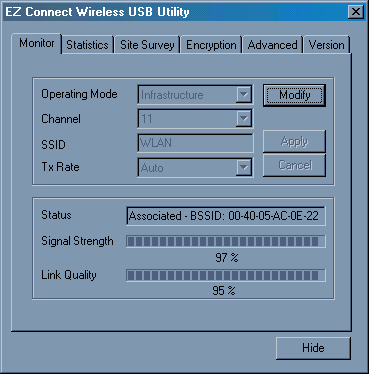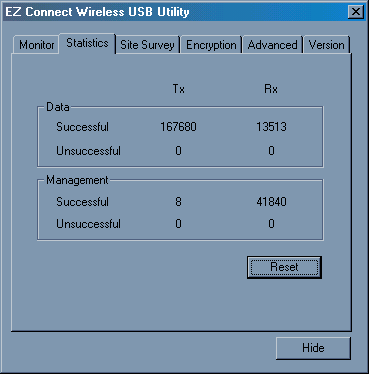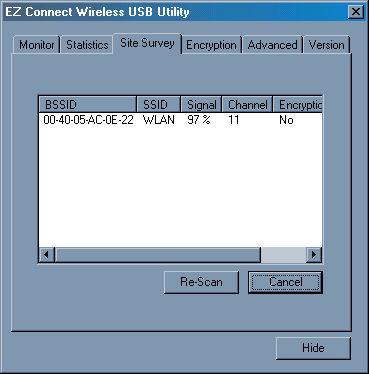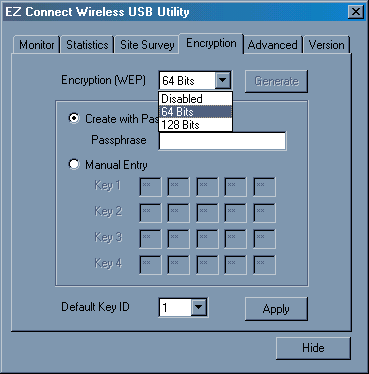Author: Tim Higgins
Review Date: 6/18/2001
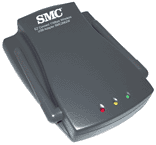
Model: SMC2662W
| Pros: | – 64 and 128 bit WEP encryption – Great performance! | |
| Cons: | – Doesn’t remember WEP keys | |
| Review Updates7/18/01 Corrected antenna info. |
The Basics |
| Indicators: |
|
| Comes with: |
|
| Chipset: |
|
| Other: |
|
Introduction |
SMC’s 802.11b USB adapter is a little on the large side, but has dual antennas, good performance, and can even be wall mounted. Performance was pretty good too! Read on for the details |
Details |
| The 2662W uses Intersil Prism II radio components, but the Atmel AT76C503a Media Access Controller (MAC). There are two dipole antennas that attach to the circuit board via MCX type connectors, so it would be possible to attach booster antennas with a little work. (You’d need to open the case to remove the antennas, since there’s a retaining ring on each antenna body.) |
Indicators consist of a red “Power” which is always lit, yellow “Rx” LED, which blinks faintly when the adapter is receiving network beacon messages and green “Tx” LED, which flashes when data is being transmitted.
A Utility program and drivers for Win 98, Me, and 2000 come on a floppy and installation on my Win98SE Compaq 1650 laptop went smoothly, although I had a difficult time installing into an older Pentium desktop.
Tip: The installer will pop up a window allowing you to set the Channel number (default is 11), Mode (AdHoc or Infrastructure), Encryption (default is disabled), ESSID (default is ANY), and other parameters. If you’re installing into a network with an Access Point (AP), you should be able to accept the defaults and get connected as long as you temporarily disable WEP on the AP if you have it enabled.
Tip: See this page if you need help configuring the card to work with an Access Point, or this page if you are trying to get a card-to-card network working.
The client Utility supplied with the 2662 covered the basics, but had a few negatives:
No Help pages: You’ll need to refer to fairly well written printed manual.
Unhelpful Tray Icon: Many client utilities will give you some indication of link status and/or signal strength if you move the mouse pointer over them. All this one will do is change color (Blue(!) for linked; Red for Unlinked).
Forgetful WEP Keys: If you disable WEP, you’ll need to re-enter them when you enable it again.
On the positive side, as the screen shots below show, you can enter four 64 or one 128 bit WEP keys. The Signal Strength indicator seemed responsive and indicative of what was happening with the signal. The Site Survey tab provides a list of in-range access points, along with SSID, BSSID, Signal level, Channel Number, and WEP status.
There’s also a tab that lets you adjust the Fragmentation and RTS/CTS Thresholds…better left alone unless you know what you’re doing!
Performance |
| I ran performance tests using the D-Link DWL1000AP Access Point as the test partner, which I’ll be using from now on for all 802.11b client adapter testing. (More details of how I tested can be found here.) |
Test Conditions: – WEP encryption: DISABLED | Firmware/Driver Versions: AP f/w: 3.0.35 |
Test Description | Qcheck Transfer Rate (Mbps) [1Mbyte data size] | Qcheck Response Time (msec) [10 iterations 100byte data size] | Qcheck UDP stream | |
(Actual throughput- kbps) | (Lost data- %) | |||
AP to Client – Condition 1 | 3.4[No WEP] | 4 (avg) | 378 | 24% |
AP to Client – Condition 2 | 3.4 | 4 (avg) | 380 | 25% |
AP to Client – Condition 3 | 3.4 | 4 (avg) | 366 | 26% |
AP to Client – Condition 4 | 3.4 | 4 (avg) | 378 | 24% |
(Details of how we tested can be found here.)
Comments: Very solid, consistent performance, and no throughput decrease with WEP enabled! With a little experimentation I found that UDP stream test errors started at a stream rate between 150 and 200kbps.
Summary |
| The 2662W would be a good solution for adding 802.11b wireless capability to a Win95, Me, or 2000 machine, especially if you don’t like cracking open your PC’s case. It was very similar in performance to D-Link’s DWL-120 (reviewed here), but has a better client manager program. Pricing is pretty good too, coming in at about $120 at the time of this review, with SMC’s $20 rebate until the end of June, making it an even better deal! |

